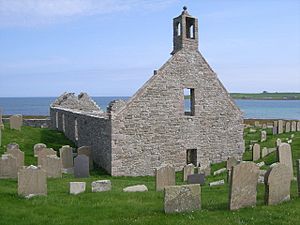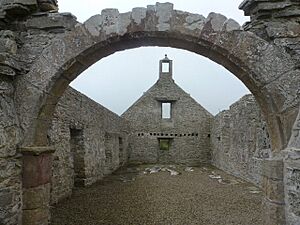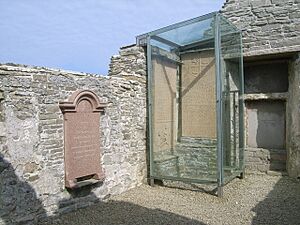Lady Kirk facts for kids
The Lady Kirk, also called St Mary's Kirk, is an old church ruin located in Pierowall on the island of Westray. This island is part of Orkney, Scotland. The church you see today was built in 1674. It was constructed on top of the foundations of an even older church from the 13th century. Inside, you can find two special grave-slabs from the 1600s. These slabs are in great condition and are protected by glass screens. They show beautiful lettering and pictures from the 17th century. In 2014, Historic Environment Scotland officially recognized Lady Kirk as a protected historical site.
Contents
Exploring Lady Kirk's History
The Lady Kirk was first built a very long time ago, in the 13th century. Not much of that original medieval building is left today. You can still see the bottom 2.34 meters of the south wall of the main part of the church, called the nave. Also, the base of the west wall, known as the gable, and a small piece of the chancel arch remain.
How the Church Changed Over Time
In 1674, the church was made bigger. The nave was expanded, and the chancel was rebuilt. The chancel became a special area, sometimes called a "laird's aisle," which was like a private section for a local landowner. A red sandstone arch connects the nave and the chancel. The nave was originally 14.5 meters long and 5.8 meters wide. After the changes, it became about 0.5 meters wider. The chancel is now slightly out of line with the nave.
Special Features and Grave-Slabs
You can see the year 1674 carved into the lowest stone of the east gable, near the roof. The west gable has a "birdcage" bellcote on top. This is a small structure that once held a bell, and it has a ball-shaped decoration called a finial. The church walls are built from rough stones, called rubble. They used smoother stones, known as freestone, and lime mortar to hold them together. The very oldest parts of the church walls were built using clay as mortar.
Two important 17th-century grave-slabs are placed inside the chancel wall. These are now protected by glass screens. The slabs are in excellent condition. They show detailed lettering and pictures that represent life and death from the 1600s. On the north wall, you can find graves for Michael Balfour, George Balfour (who died in 1657), and his wife, Marjorie Baikie (who died in 1676). On the east wall, there is Helen Alexander's grave-slab from 1676. The church and its surrounding graveyard were used until 1879.
See also
- Westside Church
- St Boniface's Church, Papa Westray
- St Olaf's Church, Unst
- St Magnus Church, Birsay
- List of churches in Orkney




